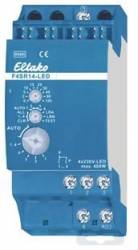Eltako F4SR14-LED - ELT F4SR14 LED RS485 bus actuator 4 channel relays F4SR14 LED
Installation > Home Automation > EIB material

Eltako F4SR14-LED - ELT F4SR14 LED RS485 bus actuator 4 channel relays F4SR14 LED
| Lieske Part No. | 628854 |
|---|---|
| Mfg Part No | 30014076 |
| EAN-Code | 4010312317006 |
| Manufacturer | Eltako |
| Here only | 75,54 EUR
89,89 EUR incl. VAT
|
Further information for Eltako F4SR14-LED - ELT F4SR14 LED RS485 bus actuator 4 channel relays F4SR14 LED
Impulse switching relay with 4 channels, 1 normally open contact each for 230V LEDs up to 400W and incandescent lamps up to 1800W, electrically isolated from the supply voltage, with DX technology. Bidirectional. Standby loss only 0.1 watts. Connection to the Eltako RS485 bus. Cross-wiring of bus and power supply with jumper. Each normally open contact can switch 230V LED lamps up to 400 watts and up to a maximum inrush current of 25A/100ms. With 32A protection, each normally open contact can switch incandescent lamps up to 1800 watts. With the patented Eltako duplex technology, the normally potential-free contacts can still switch at zero crossing when switching 230V AC 50Hz, thus drastically reducing wear. To do this, simply connect the N conductor to terminal (N) and L to K(L). This results in an additional standby loss of just 0.1 watts. If all 4 relays of the F4SR14-LED are switched on, 1 watt is required. If the supply voltage fails, the device is switched off in a defined manner. The channels can be taught in independently of one another as ES and/or ER channels. Scene control: Using one of the four control signals from a double rocker button taught in as a scene button, several channels of one or more F4SR14-LEDs can be switched on or off for one scene each. Central commands on the PC are sent using the GFVS building radio visualization and control software. To do this, teach in one or more F4SR14-LEDs on the PC. The buttons are taught in using the rotary switches and the 4 channels are tested if necessary. For normal operation, the middle and lower rotary switches are then set to AUTO. With the upper rotary switch, the EW time (0-120 seconds) for relays or the RV time (0-120 minutes) for impulse switches is set equally for all channels. If wireless motion brightness sensors FBH (master) and/or FBH (slave) are taught-in, the switching threshold at which the lighting switches on or off is set separately for each channel using the upper rotary switch. Settings for the upper rotary switch are as per the operating instructions. If wireless brightness sensors FAH60 are taught-in, the switching threshold at which the lighting switches on or off depending on the brightness is set separately for each channel using the upper rotary switch. (from approx. 0 lux in position 0 to approx. 50 lux in position 120). A hysteresis of approx. 300 lux between switching on and off is fixed. An additional RV time set is ignored. Only one FBH (master) or FAH can be programmed per channel. However, one FBH (master) or FAH can be programmed into several channels. If wireless window/door contacts FTK or Hoppe window handles are programmed, different functions can be set using the middle rotary switch in the positions AUTO 1 to AUTO 4 and a maximum of 116 FTKs can be linked: AUTO 1 = window closed, then output active.AUTO 2 = window open, then output active. In the AUTO 3 and AUTO 4 positions, the FTKs programmed on a channel are automatically linked. With AUTO 3, all FTKs must be closed for the working contact to close (e.g. for air conditioning control). With AUTO 4, one open FTK is sufficient to close the working contact (e.g. for alarm notification or switching on the power supply of an extractor hood). One or more FTKs can be programmed into several channels so that different functions are possible simultaneously for each FTK. After a power failure, the link is restored by a new signal from the FTK or with the next status message after 15 minutes. An additional RV time set is ignored. Function with FRW radio smoke detectors or water sensors as per the operating instructions. The LED under the upper rotary switch accompanies the programming process as per the operating instructions and indicates control commands by flashing briefly during operation.</DESCR

This is an offer of:
79279 Vörstetten
http://industry-electronics.com
Tel. 07666/88499-0
Fax. 07666/88499-111
Diesen Artikel finden Sie unter:
industry-electronics.com/artikel/628854

Lieske Elektronik e.K.
Reutener Str. 1079279 Vörstetten
http://industry-electronics.com
Tel. 07666/88499-0
Fax. 07666/88499-111
Diesen Artikel finden Sie unter:
industry-electronics.com/artikel/628854
